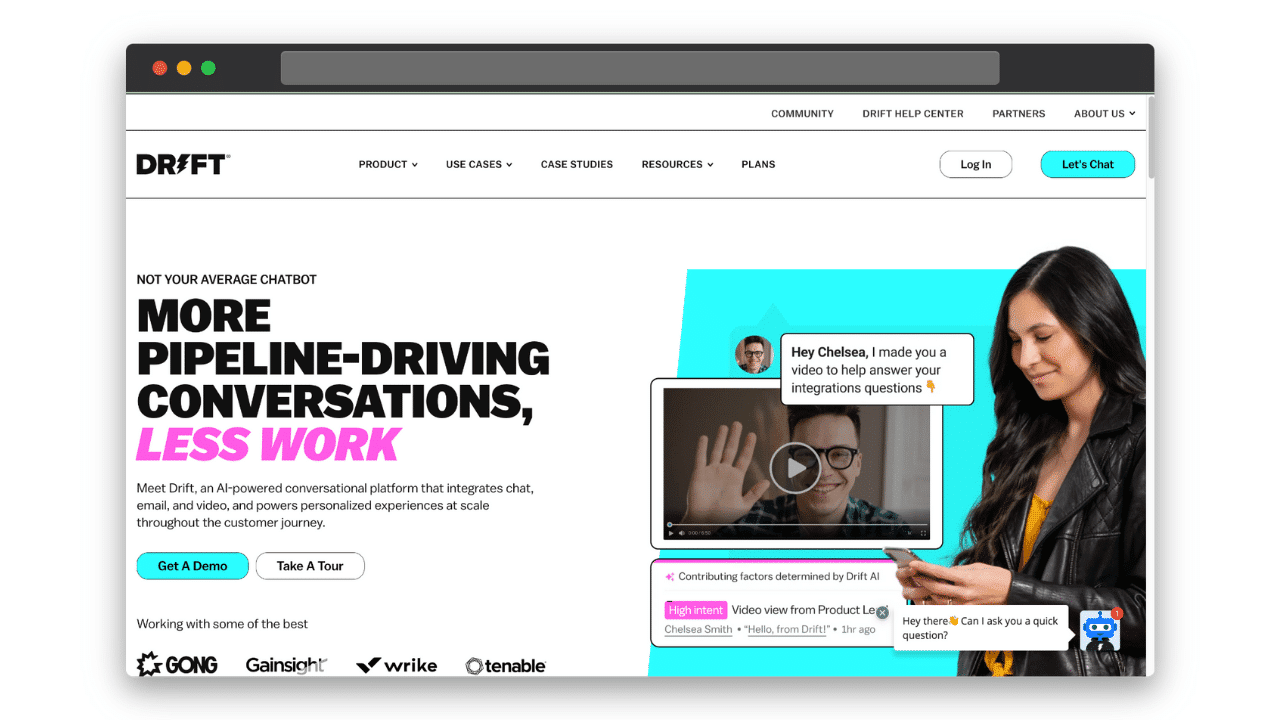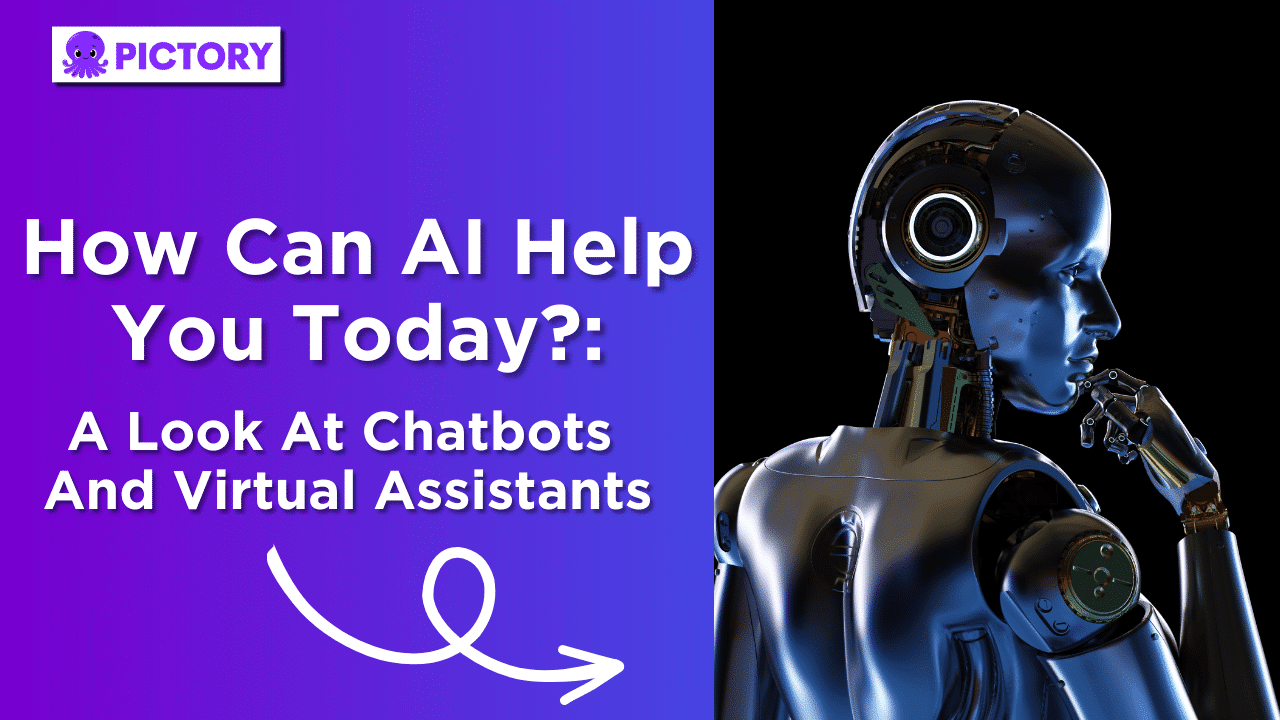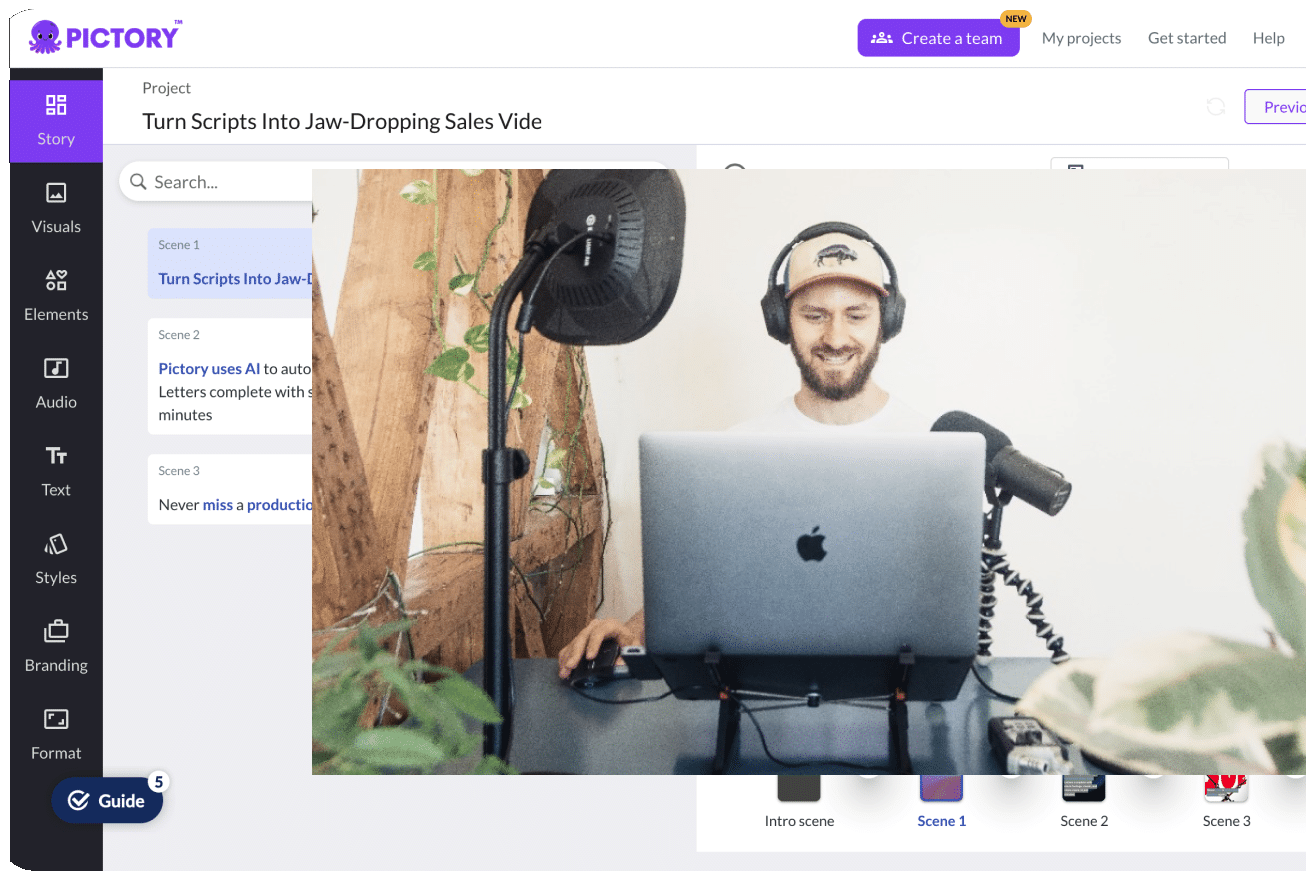AI assistants have come a long way since the early iterations of Siri or Alexa.
There are now hundreds of AI-based chatbots and virtual assistants available to help businesses with everything from customer support to scheduling appointments and taking notes.
This technology is still very new though.
It’s common for businesses to miss out on great AI purely because they don’t know enough yet.
Today, we’re changing that.
In this guide, we’re going to explore all the basics of AI virtual assistants and chatbots.
We’ll look at the differences between the two types of software, the technology behind them, and some great examples of artificial intelligence tools that can help your business today.
A chatbot can be easily integrated into a great marketing strategy.
Learn more – Pictory and ChatGPT – The Best AI Combination for Your Content Creation.
The Difference Between AI Virtual Assistants and Chatbots

Though sometimes referred to interchangeably, chatbots and virtual assistants are actually two distinct types of AI technology.
Chatbots tend to operate through a conversational user interface that feels like texting.
Although conversational AI can be quite strong, it can’t necessarily understand natural language commands.
An AI virtual assistant on the other hand operates more like an actual personal assistant.
They take a lot of the conversational elements of a chatbot and bump that up so that there’s an opportunity for longer, more in-depth interactions between the user and software.
Casual or fun conversation is more possible with a virtual assistant.
They’re also usually equipped to complete tasks on behalf of a user and respond to voice commands.
That’s the basic definition of chatbots and virtual assistants.
But here’s a closer look at how they each work and what makes them different:
Main Functions
Chatbots have mostly been developed as customer support tools.
They’re generally integrated as a company-based solution to reach out to customers and help facilitate sales.
You’ll often see them popping up on shopping sites such as Zara or H&M asking if you need help with anything.
An AI virtual assistant on the other hand can assist users with everyday tasks.
Or at least, that’s the core function of most, especially those included with smart home devices.
Alexa, for example, is an AI virtual assistant.
It doesn’t just perform a chat function but can perform tasks such as booking an appointment or sending a message on a user’s behalf.
How Chatbots Work: Natural Language Processing vs. Machine Learning
The more complex the artificial intelligence behind a virtual assistant or chatbot, the more complex tasks they can complete and the conversations they can engage with.
Natural Language Processing (NLP), which AI chatbots rely on, is a type of artificial intelligence that allows software to understand text.
Natural Language Understanding (NLU) on the other hand, upgrades this by being able to understand user intent and the context behind words.
This advanced natural language understanding is why the conversational qualities of an AI assistant are more elevated.
It’s also why they’re able to respond to voice commands.
Chatbots are sometimes powered by Machine Learning (ML) or rule-based technology.
These function by continuously learning from customer messages over time.
Rather than using artificial emotional intelligence to mimic human users in messaging apps, it relies primarily on past interactions to build its conversational abilities.
Intelligence Levels

Though AI chatbots have some contextual understanding, AI virtual assistants tend to be more “intelligent” in that they can pick up on things like empathy and slang more easily.
Depending on your business and the tasks you need your AI tool to fulfill, you may not need such advanced virtual assistants.
For many businesses focused on customer support, an AI or machine learning-powered chatbot is more than enough.
Let’s be clear, any kind of AI software is innately intelligent.
It’s simply a matter of how layered and flexible the intelligence is.
A chatbot that relies on machine learning may not be considered as advanced as voice assistants, for example.
But it’s still hugely valuable technology.
Interface
Another key difference between virtual assistants and chatbots is that the latter tend to have conversational interfaces and take the shape of a messaging app.
An AI assistant on the other hand can operate without an interface.
The Benefits of Using a Virtual Assistant or Chatbot
Intelligent virtual assistants and AI chatbots both offer extensive advantages to businesses, from saving time on tedious administrative tasks to answering customer queries and boosting the overall customer experience.
Let’s take a closer look at how these AI tools can assist you, and your customers:
Improve the Customer Experience

This is what businesses most frequently turn to AI chatbots for.
Sephora was one of the first major retailers to use one with “Sephora Assistant” which helps users with everything from matching their concealer shade to booking appointments at a Sephora counter.
They saw an 11% increase in bookings with the chatbot which supports much of the data presented by places like IBM and PWC in recent years about the fact that customers expect an online experience that mimics an in-store one.
Chatbots are a way to bring that sense of personal assistance many enjoy in a store, to the digital experience.
It also encourages more customer engagement simply by making it easier for them to ask questions and get answers quickly.
There’s none of the delay that human-based customer chats usually involve and it’s far easier with chatbots to ensure that answers given are pre-approved by the business at hand.
Most chatbots will also gather useful customer data and analyze customer behavior which businesses can then use to improve customer experience in all spheres.
Makes Customer Support Easier to Scale

Chatbots and virtual assistants are far easier to scale with a business than regular customer service teams are.
A sudden influx of customer questions would usually have the potential to cause serious backlogs and irritable customers as a result.
Still, a chatbot can help businesses avoid this common issue.
It also means that as a business grows, the pressure to hire more customer service staff need not be as much of a concern.
AI chatbots and virtual assistants, like most artificial intelligence technology, can seamlessly adapt to increases in work volumes.
As such, they can be a cost-saving measure too.
Save Time on Repetitive Tasks

Both chatbots and virtual assistants help save time and employee resources.
Thanks to their ability to understand natural language voice commands, many digital assistants simply need to be asked to schedule things like phone calls and it will immediately be added to the user’s calendar.
This speeds up daily tasks and streamlines overall workflow.
Though customer support teams can speed up responses by creating templates for answering common customer queries, even applying this can be a tedious administrative task.
Chatbots take over these repetitive responsibilities so that employee time is freed up.
For more layered queries, a chatbot is unlikely to handle everything.
However, even in the case of it being passed over to a company representative, the chatbot will have laid all the groundwork and be able to provide the initial pieces of information.
From there, a representative can take over and focus on the parts of the process they’re most needed for.
The speed at which Chatbots can assist customers also helps improve customer engagement.
Instant answers prevent customers from getting irritable and clicking away.
Chatbots have Fewer Errors
When set up properly with strong policies in place, a chatbot can treat customers with far more consistency than humans can.
This means fewer errors or the chance of bias altering the quality of customer assistance.
Similarly, an AI assistant can offer the same low error rate and consistency over a variety of tasks.
7 of The Best Chatbots and AI Assistants for Every Business
One of the easiest ways to see the full picture of AI assistants and chatbots is by looking at the platforms using this technology to its fullest.
Here are some of the best AI-based systems that can help any business expand their capabilities:
Hubspot Chatbot Builder: No Coding Required

This free chatbot builder is a favorite for many reasons, and not just because it’s budget-friendly.
It’s also great for anyone who lacks coding experience.
The platform uses data from your CRM to create a more personalized user experience.
Reviewers have praised how well it works as an integrated marketing tool.
One of its most useful tools includes creating support tickets for incoming queries so that important information is gathered about a customer before any members of the service team engage with them.
The only downside to this platform?
It’s limited to HubSpot Sales Hub users.
Drift: A Sales AI Assistant

Considered one of the best sales-focused chatbots, Drift is notably good at tasks such as qualifying leads and flagging when support staff are needed to come in and close a deal.
Each Drift plan includes onboarding, strategy reviews, a customer success manager, and generally good support.
This is quite important as, for many businesses, this may be their first foray into the world of AI bots.
It’s mostly aimed at B2B sales and marketing teams, has great integrations, and provides detailed customer data reports.
These reports give actionable insights that help to further improve the bot and a business’s overall marketing strategy.
The interface of Drift is another standout of the platform with the chatbot builder having a visual flow that makes it particularly easy for users to operate the AI technology.
Microsoft’s Cortana: The Office’s Virtual Assistant

Marketed as a “personalized productivity assistant” this virtual assistant offers speech recognition and responds to voice commands.
Available as an app in Windows 10, it was initially intended to compete with Google Assistant, Siri, and others.
It’s ended up with narrower scope, mainly streamlining administrative tasks within Microsoft Outlook and Teams.
It’s a voice assistant that makes sending emails, scheduling meetings, and other daily business tasks that much quicker.
What’s notable about the way the voice assistant works in Cortana is that if a user is in Outlook, they don’t need to address Cortana by name (as you would with Alexa).
Users simply have to turn their mic on and give their command.
For example, “Send an email to Pictory AI asking about their video transcription tools.”
For anyone trying to boost their Microsoft productivity, this intelligent virtual assistant is a niche solution.
Google Assistant: From Google Home to The Office

Google Assistant may have first launched as smart speakers for the home, as Alexa did, but it’s also one of the best AI virtual assistants for business use.
Primarily a voice assistant, it operates through natural language commands.
It can answer questions about the weather, schedule meetings, book flights, and read out messages.
It’s one of the most popular virtual assistants on the market from any of the major search engines.
This is partly because it works across IOS and Android, and is particularly useful for any business that has most of its work done through things like Gmail and Google Calendar.
Motion: AI-Assisted Project Management

Though essentially an AI calendar, Motion is hugely valuable for any business looking for scheduling assistance.
Most AI virtual assistants offer better productivity by doing tasks for users.
But this one more easily mimics real-life personal assistants by helping users keep track of all their various deadlines as well.
It helps sync schedules across big teams and timelines and even tracks how long employees take with things and adjusts things accordingly.
Wit.AI Bot and Facebook Messenger: A Social Media Chatbot

Facebook is one of the most active social media platforms in the world and the focus of most businesses’ marketing strategies as a result.
It now also offers the Wit.AI Bot Engine which uses artificial intelligence and natural language processing to mimic human conversation and help make sales through Facebook Messenger.
What’s great about Facebook’s bots is that they’re already integrated into the social media platform, have a strong conversational user interface, and Meta has provided plenty of guidelines for anyone new to AI.
Pictory AI: Speech to Text (and Vice Versa)

Ok, technically Pictory AI is not a digital assistant.
Unfortunately, we can’t help with placing phone calls, answering user queries, or looking things up on search engines.
But our platform does use AI to help businesses complete complex tasks.
Our main offering is AI-powered video editing, but we also have speech-to-text functions that turn written instructions into impactful videos.
Our platform acts as a video-focused digital assistant that saves businesses hours on editing, transcription, and other tasks.
Sign up for a FREE trial today!
Or upgrade your existing plan to explore our full suite of AI-powered video generation tools.








